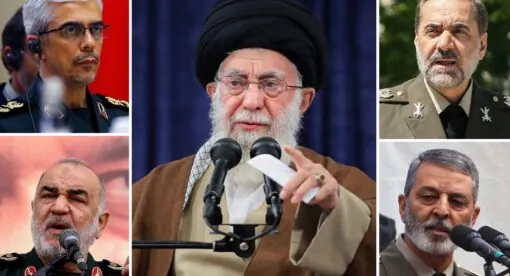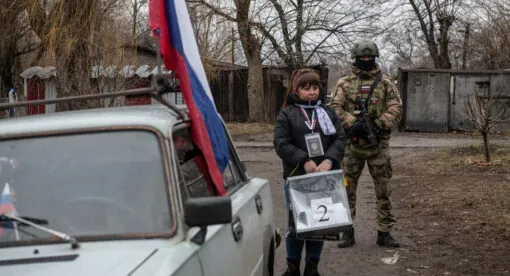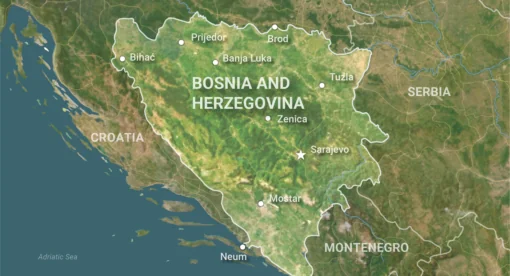Editor’s Note: This Terrain Analysis is part six of “ISIS 2020” – a series of briefings about the current status of the Islamic State by authors from different parts of the region. It is published by the Newlines Institute’s Nonstate Actors program. Parts one, two, three, four, and five were released on April 28, May 5, May 12, May 19, and May 26, respectively.
This article will analyze two exceptions. The first is the long absence of confrontation between al Qaeda and Islamic state offshoots in the Sahel area. The second is an elected official conducting negotiations with an al Qaeda offshoot. Both constitute the “Sahel exception.” The first factor has ended, but the second still holds. Al Qaeda and ISIS will continue to evolve despite the heavy French involvement in the Sahel region. The absence of policies addressing local grievances and the looming U.S. disengagement from Africa will most definitely embolden both groups and enlarge the scope of their actions in the Sahel and on the continent.
Al Qaeda and ISIS: Divergent Paths in the Same Battlespace

In October 2015, Adnan Abu al-Walid al-Sahrawi, a jihadist operative from Morocco, along with several of his men from the Murabitun, pledged allegiance to the Islamic State’s former “caliph” Abu Bakr al-Baghdadi. ISIS had set foot in the Sahel – the geographic belt running south of the Sahara Desert – and went almost unnoticed. At the same time, al Qaeda in the Islamic Maghreb (AQIM) was planning a comeback through the unification of several scattered groups in northern and central Mali, culminating in the formation of Jamaat Noussrat al-Islam wal Muslimin (JNIM) in early March 2017. Between the time of al-Sahrawi’s pledge of allegiance to ISIS and the creation of JNIM, AQIM had claimed attacks as far away as Ouagadougou, the capital of Burkina Faso, and Grand Bassam in Cote d’Ivoire.
Al Qaeda proved able to take initiatives in the Sahel at a time when the Islamic State was concentrating all attention in other areas of the world. And for the first time, a political figure – Iyad Ag Ghali, a prominent Tuareg tribal leader and long-time rebel commander – headed JNIM. Joining him in command were Djamel Okacha (also known as Yahya Abu al-Humam), a veteran Arab Algerian AQIM military commander, and most importantly Muhammed Kufa, a well-known minor religious figure among the Fulani ethnic group. Ghali confirmed the local credentials of a sustained Tuareg insurgency, Okacha provided a link to al Qaeda, and Kufa gave it reach further south to central Mali and beyond by boosting recruitment among the Fulani population.
The two transnational jihadist groups experienced steady – and parallel – growth. Despite claims that AQIM and ISIS were cooperating, there has not been any evidence of organizational cooperation between the two groups. Family and tribal ties are strong among the leaders and recruits, so a degree of tolerance existed, and some coordination may have occurred on a personal and very local level. Any such patterns never amounted to “cooperation” between al Qaeda and ISIS in the Sahel.
American and local officials pointed to “complex” deadly attacks to suggest the two groups worked together. The complexity of the attacks, however, reflected improvements in coordination among the attackers, whether belonging to JNIM or ISIS, who were able to surprise mostly unprepared and poorly commanded local forces. The Inates military facility in Niger was even attacked more than once, suggesting poor command and preparation rather than surprise. Both al Qaeda and ISIS got better at manufacturing improvised explosive devices, at maneuverability in terms of targeting, and in command and control abilities. These groups are also still using conventional methods of fire support with mortar rounds and heavy machine guns, sending suicide attackers either on foot or in vehicles loaded with explosives, followed by the rest of the attackers once the first defenses are breached. So far, the militant groups have used drones only for propaganda purposes, and the sole use of an anti-tank guided missile on record is a unique failed shot in Niger during the Islamic State’s first attack on Inates in July 2019.
The End of the No Clash Zone

A few months ago, the Sahel was the only region where both al Qaeda and ISIS were steadily growing without going into full confrontation – an exception that fell apart completely in April. The evolution of ISIS in al Qaeda territory in the Sahel has many similarities with its evolutions in other parts of the world where an absence of clashes did not indicate cooperation. Similar tribal, local, or interpersonal dynamics prevailed in Yemen or Syria in the early stages of building ISIS’s influence before full-blown clashes played out. In Yemen, for instance, the death of prominent figures from al Qaeda in the Arabic Peninsula – like Nabil al-Dahab or Mamun Hatem, who were among those preventing an escalation in Yemen – contributed to the eruption of fighting. In Syria, and despite the high death toll that resulted from clashes between the two groups, areas like parts of Ghouta or the Yarmuk camp experienced no such fighting because of various factors like personal relations between the commanders that prevailed over ideological animosity.
In the Sahel, three important AQIM commanders played this role to a certain extent. The first is al-Humam, mentioned earlier, one of the rare al Qaeda commanders who praised the Nov. 13, 2015, ISIS Paris attacks. The second is Abu Iyad al-Tunsi, the head of Ansar al-Shariah and member of the AQIM Shura who, despite the rifts in Libya’s Derna and in Egypt’s Sinai, thought that ISIS could be “brought back on the right path.” A notable number of his Ansar al-Shariah recruits were already in the ISIS ranks in the Levant, and some held important positions. Both these men played a role in delaying the confrontation. Both were killed by French forces on Feb. 21, 2019, in Elaka, north of Timbuktu. AQIM eulogized them officially together a year later. The third AQIM commander that played a similar role is Abu Yahya al-Jazairi, a veteran AQIM and JNIM military leader killed during an attack against Malian armed forces in Bamba on Apr. 6, 2020.
In an interview with the author, AQIM Shura council head Abu Obeida Youssef al-Aanabi addressed his group’s relationship with al-Sahrawi and the Islamic State. At first, al-Aanabi did not wish to address the matter. When he did, he still avoided outrightly attacking ISIS, saying, “they lost their way … we invite them to come back to the right path.” He did not label them as deviants or extremists, as is usual elsewhere. On Jan. 17, 2020, Kufa issued an official audio mentioning the 13 French military personnel killed in action in Indelimane on Nov. 29, 2019, indirectly praising – without naming – ISIS, who claimed the attack. This audio was issued exactly a week after the first ISIS official production out of the Sahel region. In early April 2020, the author obtained audio recordings of Kufa explaining to an assembly in Fulani, most probably of fighters or new recruits, the origins of the discord between al Qaeda and the Islamic State.
The recent statements from Kufa suggest that the fear of defections from JNIM to join ISIS was real and justified a fight. His statements also suggest that recruits are receiving ideological teachings focused on building committed and dogmatic fighters. In the same line of efforts, an official audio of Abdelmalek Droukdel (also known as Abu Musab Abdel Wadoud), head of AQIM, was issued on March 16. Among many things, he stressed the “duty to avoid harming ordinary Muslims and not to attack civilians among them,” in contradiction to the still dominant local popular perception of ISIS’s extremist attitude toward al-Aama, or “the common Muslim,” though he avoided naming the group.

This “exception” came gradually to an end. It could have gone either the Yemeni way, with clashes erupting after the death of prominent leaders with personal relations on both sides, or the Syrian way, through a quest for dominance over limited local resources, or a mix of the two scenarios. It ultimately went the Somali way: As al Shabaab did, AQIM’s leadership took the decision to start a fight in order to prevent ISIS from creating a stable stronghold in its most vital territories.
The conflict started with very limited fighting in central Mali, but neither group confirmed nor spoke publicly about the clashes. During this stage, JNIM denied to the author two fake statements issued in the name of the group. The full-blown attack on JNIM calling Ghali and Kufa apostates came in a three-page article in the weekly ISIS magazine, al-Naba, on May 7. JNIM is accused of being part of the military effort, “along with the crusaders,” to uproot ISIS from the three borders area between Mali, Niger, and Burkina Faso, and of “protecting the borders of Mauritania and Algeria,” hinting about rumored tacit deals with local power brokers to refrain from fighting in these areas.
Before al-Naba made it public, two important Islamic State video productions should be taken into consideration. On Jan. 11, 2020, ISIS issued its first long production out of the Sahel region. It was a show of force and defiance against AQIM on its turf, with an ideological twist, since it insisted on the idea that al-Sahrawi vowed allegiance “to preserve the unity of the ranks,” hinting that AQIM was an obstacle to unity. The other production came on April 29 from Yemen, which has a special place in jihadist spheres as “the land of wisdom and faith.” A few minutes of the 52-minute video were a direct attack on AQIM for the way it managed northern Mali in 2012 and for the calls it made to avoid attacking the Ennahda government in Tunisia. Combat was already raging, but those statements ended any hopes of returning to a state of non-aggression. Adding to the attack on AQIM is audio released May 28 in which the Islamic State’s spokesman accuses “the apostates of al Qaeda,” among other things, of fighting ISIS “on behalf of the crusaders in exchange of negotiations [with Bamako]” ending with, “only steel faces steel, if they go back to fighting us we will fight them back and we promise them defeat.” He said ISIS had delayed fighting with al Qaeda for years.
Before these declarations, ISIS had already ventured far from its sanctuary along the three borders into the heart of AQIM’s turf and along its logistical routes in northern Mali and the border region with Algeria, disturbing whatever “non-aggression” agreements with local power brokers. Two “minor” events in southern Algeria had already hinted at the end of the status quo: an Algerian armed forces operation in November 2019 at Tamanrasset that led to the killing of a mid-ranking figure of the Islamic State, Bouba Ould Aweidine; and a suicide attack on an army barrack in Timiaouine in February 2020.
Prior to that, ISIS conducted significant attacks showing its reach in three different countries: the Koutougou attack in Burkina Faso on Aug. 10, 2019; in Mali on Nov. 1, 2019, against the Indelimane army barracks (which were constructed and equipped with help from France and the European Union); the second Inates attack in Niger on Dec. 10, 2019, that forced French President Emmanuel Macron to delay the “Pau summit” until January; and the Jan. 9, 2020, Chinagodrar attack in Niger, the deadliest attack by ISIS in the Sahel region, with more than 100 casualties.
ISIS’s View of Official Negotiations with al Qaeda
What was once a “secret de Polichinelle” (an alleged secret known to many people) came out into the open on Feb. 10, when Malian President Ibrahim Boubaker Keita declared on France24 that negotiations with two jihadist figures in northern and central Mali – Ghali and Kufa, the two most prominent leaders of JNIM – were not only on the table but would be welcome. This announcement came days after the Pau summit that Macron had called for “to set things straight with G5 leaders” (the G5 Sahel, consisting of Burkina Faso, Mali, Mauritania, Niger and Chad) about French engagement in the Sahel region. As an outcome of the Pau summit, the countries involved named a target for counterterrorism efforts: ISIS in the three borders region between Mali, Burkina Faso, and Niger.
The Malian president announced negotiations with the al Qaeda affiliate with tacit French approval, knowing that the previous administration of President François Hollande was against such negotiations. France had two objectives for supporting the talks: to divert more forces away from the fight against JNIM and toward a growing Islamic State, and to create a rift that would push the most radical elements of JNIM to join ISIS. It is easier to internationally raise funds to counter the Islamic State, which is easier to fight locally with “gloves off” because the group is less entrenched in local dynamics than al Qaeda is and has, for the time being, limited popular support. This situation could change quickly in the wake of the latest reports of human rights abuses at the hands of government forces and militias.
JNIM, still the strongest and most dangerous militant group in the Sahel, met the official announcement with a statement approving negotiations with no preconditions except “the departure of the occupying French forces.” But aware of the “discredit” that such negotiations could bring on the group, JNIM enhanced attacks in an obvious move to hold and reassure its own ranks. The Taliban – to which JNIM has an allegiance, as do all al Qaeda offshoots – used a similar strategy when negotiations were on the table: fighting while engaging in talks.
The effect of JNIM’s acceptance of negotiations emboldened ISIS as many recruits joined its ranks from the Fulani community in Mali and Niger – a community that had provided JNIM with recruits before. Kufa was forced to seek help from other ethnic JNIM components in fighting in central Mali. This could put ISIS in the Sahel in a situation similar to the one ISIS faced in Syria in 2013, when the group was uprooted from many areas before it regrouped and seized most of the east and the north. The ISIS commander in the Sahel, Abdel Hakim al-Sahrawi heading mostly Fulani fighters reached out to Kufa with a message, which the author has seen. In the message, he asked for a truce and the respect of rules of engagement and warned Kufa against infighting among the Fulani.
The Likelihood of Further Violence
JNIM is strong, rooted, and willing to negotiate, though it is still fighting governmental forces in Mali, Burkina Faso, and Niger and remains a target for French forces. Institutionally, AQIM is approaching local issues and grievances, in a more pragmatic way and with a kind of a new “nationalist” twist in its rhetoric. A few years back, it would have been unimaginable to see the Malian or the Algerian flags in an al Qaeda official production. The Taliban’s “wins” on the diplomatic scene might be encouraging al Qaeda members who advocate a more local approach to jihad, taking into consideration local dynamics and negotiations and getting away from the idea of a never-ending “epic battle.”
The G5 is directing its efforts toward uprooting ISIS, which it sees as the biggest threat, while hoping to drain a number of JNIM’s most radical recruits into ISIS, thereby weakening both groups. If, and only if, ISIS is contained, the G5 surely will shift its focus back to JNIM. In parallel, individual governments are conducting efforts to encourage the clash between the two groups either by targeting jihadist leaders on both sides or by numerous psychological operations conducted on a very local level. But as in other theaters, fewer precautions regarding civilians are being taken on the ground, and government forces are randomly arming local militias, adding to the human rights abuses already happening at the hands of those forces. This situation is fueling recruitment to both a cross-border ISIS and JNIM, which are getting more and more local recruits but still have commanders from different countries. A geographical continuum between Somalia, Chad’s Lac region, the Sahel, and even Libya will not be hard to achieve for jihadist groups if the situation keeps deteriorating. Without the proper social, political, and economic answers to popular grievances, violence will prevail.
Wassim Nasr is a journalist with France24 and a jihadism expert. Nasr is the author of Etat islamique, le fait accompli (Plon) 2016. He is also a consultant for Terror Studios (2016) International Emmy Awards (2017) nominated documentary. Follow him @SimNasr
The views expressed in this article are those of the author and not an official policy or position of the Newlines Institute.







